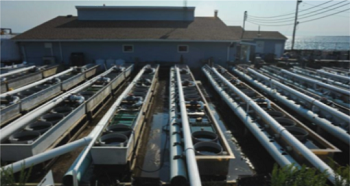Oysters play a pivotal role in the ecosystem, with one adult oyster capable of filtering 35-50 gallons of water per day.
Islip’s website notes that hurricanes, pollution, and overharvesting have devastated the shellfish populations that once formed the basis of the nation’s largest shellfishing operations and protected the environmental quality of the Great South Bay.
“To combat this, the Town of Islip’s robust Bay Bottom Licensing Program generates millions of oysters and clams each year, helping to improve water quality and preserve our beloved environment,” reads the town’s website.
Underscoring the efforts undertaken by the town, Islip produced the short film The Blue Point Oyster.
In the film, Supervisor Angie Carpenter (R-Sayville) outlines the various efforts, starting with the shellfish cultivation center in East Islip, as well as the difficulties faced by hurricanes and overharvesting.
“Now the town of Islip manages a robust Bay Bottom Leasing Program that generates millions of oysters and clams each year,” continues Carpenter.
The shellfish hatching facility used to be a bathhouse before the town of Islip took it over in 1976 and renovated it to turn it into a hatchery.
The documentary outlines the seeding process. Some of the shellfish given are given to local farmers for harvest, while others are placed into the bay for resource enhancement.
Going into the history of shellfish in the region, the film highlights the stark population decline in shellfish that occurred between 1940 to 1980. However, the demand for shellfish has not dropped since then, and in fact many restaurants desire locally produced shellfish – even today.
“Oysters are known as ecosystem engineers,” says a hatchery employee in the film. “They are great for the environment; they’re well known for filtering the water and they provide shelter for other animals.”
Narrators also mention the nitrogen and carbon filtered out of the water as reasons for the hatchery and other programs.
The more clams and shellfish in the bay, the higher the water quality. They do this by consuming the algae, which has the twin advantage of fighting brown tides.
The mission is a year-long endeavor, with different phases of seeding and leasing out the shellfish for farmers.
The sustainable Bay Bottom Leasing Program protects the environment and farmers.
The leasing programing is in phase two of three, with the third phase being deep-water leasing. There is a 15,000-acre parcel that should be able to accommodate 134 harvesters. Phase three is starting out small, adding around 10 harvesters per year to make sure the sites are being used effectively. Phases one and two occur in shallow water. Once phase three begins, it will all be bottom cages as opposed to the floating gear currently used. Phase two is currently permitted out. With the addition of phase three, it will produce an additional benefit for the bay.
“It will take more time and energy and money for our growers,” says a narrator, “but once it gets going, it should be very successful like phase one and phase two.”
Phase three is slated to open in the area of the bay near Heckscher State Park, which used to be of ecological significance before the depletion of the shellfish population. It has not been ecologically active since the late 1800s.
The Bay Bottom Program was started in 2009 with 95 acres and expanded to 125 acres, phase one and phase two, respectively.
“It’s difficult to conceive if we can get the population back to where it was,” admittedly states another in the documentary, referring to man-made damage and the ruinous impact of the Hurricane of 1938.
In 2022 alone, the town produced 10 million clams and 13 million oysters. With this, they manage 20,000 acres.
Economically, there is a much higher demand for oysters over claims, leading to their popularity with farmers.
According to Cornell cooperative extension/ Stony Brook University Study, Islip’s Hatchery performs the best in terms of disease resilience when compared with other hatcheries in the region, the documentary states.
There is currently a long waiting list for the Bay Bottom Leasing Program. The hatchery provides assistance in terms of getting started and questions that surface from farmers.
Farmers have noted that the spawning behaviors from their oysters are evident across the Great South Bay, with shellfish seen on docks and other hard substrates. Despite the sporadic growth, residents are reminded not to harvest these oysters and to only engage in legal farming practices. Illegal harvesting and farming practices can lead to illnesses and environmental degradation.
While the documentary acknowledges the difficulty of becoming a farmer, there is a waiting list to become a grower. There are now many resources available via the town to help prospective farmers.
The documentary can be watched on the town’s website: https://islipny.gov/news/ announcements/1885-the-blue-point-oyster-an[1]original-documentary







